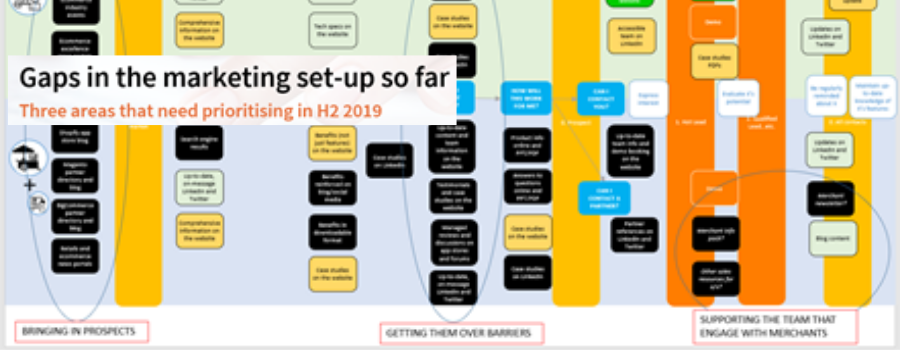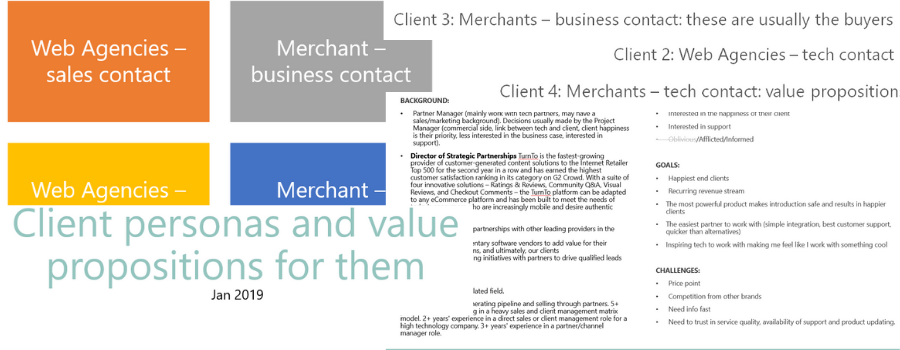Knowing where to put your marketing effort saves many small businesses a lot of time, money and energy. Identifying the journeys your key customer groups usually take to the point where they buy your products/services highlights the gaps. Assuming your product and market are right for each other, plugging these gaps will increase sales.
Background
This Swedish tech startup has developed a system that uses artificial intelligence to put the products people are most likely to buy in front of them in ecommerce stores. It was bought out by one of its own customers and almost all the staff moved to the parent company at the point they brought us onboard.
The industry
With the growing number of e-commerce stores comes a growing number of competing products and the market is more and more competitive.
The problem
The key challenges our client faced were:
- No team and the need to rebuild it fast, while running the tech and marketing sides for existing clients
- A need to grow rapidly to become profitable
- A move away from free basic accounts and towards larger clients – no new freemium customers wanted
How we jumped in
The client approached us from a referral by a member of their team. They investigated other options and chose Write in Danderyd for our broad expertise and, as a smaller organisation, so that they would be an important part of our business.
The client’s goals for us
The client identified two key goals for our time with them:
Developing the marketing strategy while taking rapidly restarting the marketing tactics
Normally, we would work to set the marketing strategy first and then action the tactics but, in this case, we had to run both concurrently to support the ongoing customers and potential customers already in the pipeline.
What we did to help them
|
To understand where the client fitted in the marketplace and what its differentiating factors were (in the minds of potential customers), the agency started with a full competitor and industry analysis. This gave us a complete picture of the where the client could best compete and specific factors, such the ease of buying competing products and reviews of the support they received. |
The second stage was to formulate a marketing strategy that fully supported the efforts of sales team, focusing on their current target market in the short-term and, longer-term, scaling effectively to reach wider target markets and reduce the risk of churn.
The key to this side was the clear identification of the journey potential customers took before purchasing the system – which often included multiple people, time and contact points with the client.
The journey of one target market group looked like this:
The key to this side was the clear identification of the journey potential customers took before purchasing the system – which often included multiple people, time and contact points with the client.
The journey of one target market group looked like this:
Identifying where marketing was important in the buyer journey and what current gaps there were helped us develop a clear strategy with tactics for the business.
Search engine traffic, for example, was one missing element. It was rapidly growing in importance for the client, as industry awareness of the product availability increased and potential customers searched for solution providers.
The client needed more leads coming into the top of their sales funnel and we identified search traffic as one important source of them.
The client needed more leads coming into the top of their sales funnel and we identified search traffic as one important source of them.
The next strategic area was the clarification of who the system was for – what attributes did the ideal customers have and how it was best to reach their trigger points for buying the system.
We built ‘personas’ for each identifiably different target customer group, looked in detail to find out who they were, what level of buying power they had (to see if the client needed to present the system to additional people before a buying decision could be taken), what their technical knowledge level was (to highlight how content targeted at them should be written), their likely goals and their likely challenges.
The final step was to identify each personas’ set of value propositions – what made this system stand out from the competition and how could they succinctly say it. We produced sets of value propositions for each target market group and then narrowed it down into the best, most useable statements that would help support the buyer through their journey.
We built ‘personas’ for each identifiably different target customer group, looked in detail to find out who they were, what level of buying power they had (to see if the client needed to present the system to additional people before a buying decision could be taken), what their technical knowledge level was (to highlight how content targeted at them should be written), their likely goals and their likely challenges.
The final step was to identify each personas’ set of value propositions – what made this system stand out from the competition and how could they succinctly say it. We produced sets of value propositions for each target market group and then narrowed it down into the best, most useable statements that would help support the buyer through their journey.
Area 1 - urgent content marketing and website management
|
We needed to somewhat follow the existing tactics for the first few months to show that the company was still running as it should be and to be consistent in the eyes of current clients. We prepared website, blog, email and social media content that married the style of the existing content with the shift in target market away from the freemium model. Content was created to effectively communicate individual elements and specific benefits of the system to potential clients, often in visual form. |
One of the first tasks we undertook was to move the company website from Word press to an easier to self-manage CMS system to allow the company more stability and ease of use. The original site was difficult and time-consuming to edit and the team wanted something that could change with them as they grew.
We created a total replica of the original site in a system that then took 10 minutes to post a professional, on-brand blog post on instead of several hours and design skills.
We ran a full website review initially and provided the client with a comprehensive list of changes and improvements to boost search traffic and the usability of the website. We worked with the team to start implementing these changes.
We created a total replica of the original site in a system that then took 10 minutes to post a professional, on-brand blog post on instead of several hours and design skills.
We ran a full website review initially and provided the client with a comprehensive list of changes and improvements to boost search traffic and the usability of the website. We worked with the team to start implementing these changes.
Area 2 – strategic branding
|
We prepared a full suite of branded materials to enable the marketing efforts and sales team efforts to push ahead efficiently and effectively.
This included starting from the beginning, producing versions of the existing logo in all the formats needed, printing business cards, designing templates for the main formats and developing a key set of brand guidelines based on the existing look and feel, to protect the brand value. |
Area 3 – sales strategy, tactics and materials
Although not part of the original brief, sales support became our biggest area of work and we pivoted to meet this need.
Sales support was provided in series of email templates, email processes, CRM system support, sales presentation design and content, flyer design and the printing and shipping of business cards out to an event.
Sales support was provided in series of email templates, email processes, CRM system support, sales presentation design and content, flyer design and the printing and shipping of business cards out to an event.
We created content and materials to support partnership sales.
We created email content for each target market to support the sales team in their efforts to built up requests for demos of the system. On our recommendation, a series was used, and results started to appear from the fourth email in the series.
We worked with the client’s CRM system to get them automatically to the correct recipient.
We created email content for each target market to support the sales team in their efforts to built up requests for demos of the system. On our recommendation, a series was used, and results started to appear from the fourth email in the series.
We worked with the client’s CRM system to get them automatically to the correct recipient.
Area 4 – preparing for the future without us
|
As well as leaving the client with a clear marketing strategy and tactics to fill the gaps, materials and a mass of sales and marketing content, we also created guides, such as social media response guidelines and case study templates, so that they could function well without us. Content was created and planned out for the rest of the year. |
What the project achieved
In this case, the client needed both a quick fix and a strategic plan. We supported them so that they could get internally back on their feet without disruption to the existing clients and prospect clients in the pipeline and left them with the tools, processes and materials to achieve their growth ambitions.
Do you have a complex situation which requires strategic and tactical support?
Read more about the services we offer above and/or get in touch to talk us through your needs.
Read more about the services we offer above and/or get in touch to talk us through your needs.












